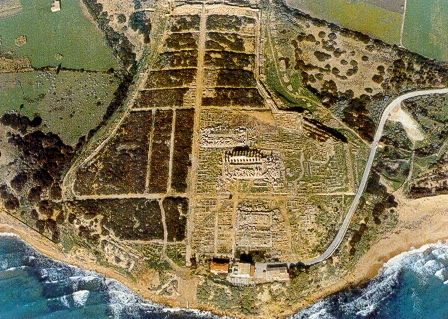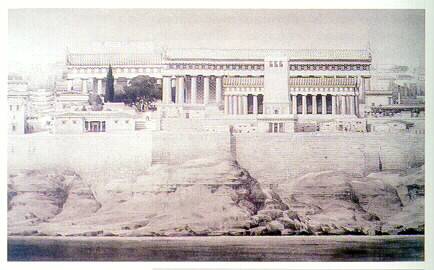 Little is known about the divinities worshipped in this sanctuary, the
very cul centre of the city, or about the ways in which worship. Tthis is
the reason for the usual naming of the temples with the letters of the
alphabet. According to the research of E. Gabrici and more recently of A. Di Vita, the main urban sanctuary, was marked, to the
North and South, by enclosing walls (temenos), whose position coincides with that
of the oldest East West roads of the first quarter oft he VI centurv B.C.
The steep slope to the East was bounded by the poligonal course of the
wall while the boundary to the West remains unknown. The first temple of this sanctuary, like those of the suburban
shrines to the East and West of the city, had the simple shape of the elongated
megaron. Their monumentality is only emphasized in the precise isodomic work that is entirely carried out in
stone. Towards the middle of the VI century, the central megaron war teplaced by a large peripteral
temple, temple C. The large cinerary altar was built in front of its Eastern facade and quite distant from
the temple. As a result the whole temenos was considerably widened towards the East by means of a enormous artificial
embankment which was supported by a huge with steps. An L shaped stoa defined and
enclosed the shrine towards the East and the South. During the last quarter ofthe VI century
B.C., a second great peripteral temple was added to the North. This
temple, called tempie D, was also preceeded by an artificially constructed square. The
singular position of the altar that is placed obliquely and immediately in front
of the temple gives rise once again to the hypothesis of an earlier predecessor. Among
the other cult monuments two other altars may be observed, thet which runs along
the Southern temenos wail in the East West direction and the well-preserved triglyph altar situated in the North Eastern
corner ofthe shrine. During the first half of the V century, the Western boundary was redefined with the continuation
of the large main road of the Acropolis towards the South. At the same time a new sacred area with the two temples A
and 0 was created. Of these temples, however, only the first was completed together with its magnificient
altar. Little is known about the divinities worshipped in this sanctuary, the
very cul centre of the city, or about the ways in which worship. Tthis is
the reason for the usual naming of the temples with the letters of the
alphabet. According to the research of E. Gabrici and more recently of A. Di Vita, the main urban sanctuary, was marked, to the
North and South, by enclosing walls (temenos), whose position coincides with that
of the oldest East West roads of the first quarter oft he VI centurv B.C.
The steep slope to the East was bounded by the poligonal course of the
wall while the boundary to the West remains unknown. The first temple of this sanctuary, like those of the suburban
shrines to the East and West of the city, had the simple shape of the elongated
megaron. Their monumentality is only emphasized in the precise isodomic work that is entirely carried out in
stone. Towards the middle of the VI century, the central megaron war teplaced by a large peripteral
temple, temple C. The large cinerary altar was built in front of its Eastern facade and quite distant from
the temple. As a result the whole temenos was considerably widened towards the East by means of a enormous artificial
embankment which was supported by a huge with steps. An L shaped stoa defined and
enclosed the shrine towards the East and the South. During the last quarter ofthe VI century
B.C., a second great peripteral temple was added to the North. This
temple, called tempie D, was also preceeded by an artificially constructed square. The
singular position of the altar that is placed obliquely and immediately in front
of the temple gives rise once again to the hypothesis of an earlier predecessor. Among
the other cult monuments two other altars may be observed, thet which runs along
the Southern temenos wail in the East West direction and the well-preserved triglyph altar situated in the North Eastern
corner ofthe shrine. During the first half of the V century, the Western boundary was redefined with the continuation
of the large main road of the Acropolis towards the South. At the same time a new sacred area with the two temples A
and 0 was created. Of these temples, however, only the first was completed together with its magnificient
altar.During the IV century B.C. the whole sacred area was occupied by the houses of the Punic city. The Greeck cult scemed to be over, while in the pronaos of temple A a Punic sbrine was installed. Only near the South East corner of tempie C, was built a new shrine, shortly before the definitive end of the city (250 B.C.). This was a small temple in pure Greek-Hellenistic style, temple B, famous for the rich polychromy of its strutture. The Punic settlement non only occupted the ruins ofthe Greek houses but also the areas that up to now were free of the great temene around the temples. The irregular urban layout in these areas almost recalls the North African souks and indicates the profound social change. The particular "framework" building technique of the walls is noted, but so are also elements of a charaeteristic, even if modest, luxury in the homes, as may be scen in the large cisterns, the bathrooms and the floors in opus signinum as well a few rare simple mosaics. After the destruction of the city in 250 B.C. and after the following long centuries of decay, life only returned to the ruins during tbc Byzantine era. And the castle that was erected on the ruins of the temple A and, according to a plant that was widespread in North Africa from the late-antique age, may even have been built during the Arab occupation after 827 A.D. |
